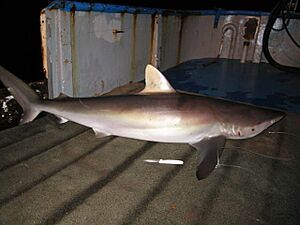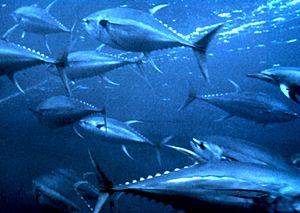Silky shark facts for kids
Quick facts for kids Silky shark |
|
|---|---|
 |
|
| A Silky shark at Jardines de la Reina, Cuba | |
| Conservation status | |
| Scientific classification | |
| Kingdom: | |
| Phylum: | |
| Class: | |
| Subclass: | |
| Order: | |
| Family: | |
| Genus: | |
| Species: |
C. falciformis
|
| Binomial name | |
| Carcharhinus falciformis |
|
 |
|
| Map of where the Silky shark is found (in dark blue), and where the Silky shark is said to be found (in light blue). | |
The Silky shark (Carcharhinus falciformis) is a type of shark that belongs to the Carcharhinus group, part of the Carcharhinidae family. These sharks mostly live in warm parts of the Atlantic, Pacific, and Indian Oceans.
Silky sharks are large and slender. They can grow up to 3.3 meters (about 10 feet) long. They get their name because their skin feels very smooth, almost like silk. These sharks eat bony fish like tuna and mackerel. They also enjoy molluscs such as squid. Sometimes, they even feed on dead whales. The IUCN lists the Silky shark as "Near Threatened." This means their numbers are getting low, and they might be in danger.
Contents
What Does a Silky Shark Look Like?
The Silky shark is a big, slim shark. It has a long, rounded snout. Its first dorsal fin (the one on its back) is slanted and has a blunt top. This fin is located behind its pectoral fins, which are long and thin. The second dorsal fin is small but has a very long tip at the back.
Silky sharks are usually dark grey with a bronze tint. Some can even be golden-brown. Their bellies are white. The tips of all their fins, except the first dorsal fin, are dark. This dark color is easier to see on younger sharks.
Their upper teeth are wide and triangular, slanting towards the back of the jaw. These teeth have rough, jagged edges. The lower teeth are sharp with smooth edges.
The skin of the Silky shark has tiny, overlapping scales called dermal denticles. These scales are packed so tightly that they make the skin feel smooth, like silk. This is how the shark got its name!
Silky sharks can grow up to 3.3 meters (10 feet) long. Male sharks become adults when they are about 2.2-2.3 meters long (around 9-10 years old). Females grow a bit larger, reaching maturity at 2.3-2.5 meters (about 12 years old). These sharks can weigh around 350 kilograms (770 pounds).
Where Do Silky Sharks Live?
Silky sharks are common in warm tropical and subtropical waters. You can find them in the Atlantic, Pacific, and Indian Oceans. In the western Atlantic, they live from Massachusetts in the U.S. down to Brazil. This includes the Gulf of Mexico and Caribbean Sea. In the eastern Atlantic, they are found from Spain to Angola.
In the western Indian Ocean and the Red Sea, they live from Tanzania to Mozambique, including Madagascar. In the middle and eastern Indian Ocean, they are found from the Maldives and Sri Lanka to western Australia. In the western Pacific, they range from China to New Zealand, including the Hawaiian Islands. In the eastern Pacific, they are found from Baja California to Peru.
Silky sharks mostly live in the pelagic zone, which is the open ocean away from the coast. However, they have also been seen in shallower waters, as shallow as 18 meters (56 feet). They are fast and active sharks that prefer warmer water, around 23°C (73°F).
They often live near the edges of continental shelves and deep coral reefs. These areas have lots of food. Silky sharks usually swim from the surface down to at least 500 meters (1,550 feet). But they have been caught in waters as deep as 4000 meters (12,400 feet).
Studies show that groups of Silky sharks often have males and females of similar sizes. Young Silky sharks stay in coastal nursery areas. As they grow older, adult sharks move further offshore into deeper waters.
What Do Silky Sharks Eat?
Silky sharks mainly eat bony fish. Their favorite foods include tuna, mackerel, sardines, mullets, groupers, and snappers. They also eat squid, paper nautilus, and swimming crabs. There is also proof that they will scavenge on dead whales.
These sharks are excellent hunters because they have a great sense of hearing and smart hunting methods. They often work together to "herd" groups of small fish towards the surface. This traps the fish. Once the fish are tightly packed, the Silky sharks attack them very quickly, often eating the whole group.
Silky Shark Reproduction
The Silky shark is viviparous. This means that the mother gives birth to live, fully formed pups, instead of laying eggs. In the western North Atlantic, female sharks mate in late spring (May-June). They give birth about 12 months later, in the same time period the next year. This is called the gestation period.
The number of pups in a litter can vary. In the western Atlantic, a mother can have 6 to 14 pups. In the eastern Atlantic, it's usually 9 to 12 pups. In the western Indian Ocean, it's 9 to 14, and in the central Indian Ocean, it's 2 to 11.
Young Silky sharks spend their first few months living in coral reefs. By their first winter, they move out into the open ocean. In the western North Atlantic, many nursery areas are found along the Caribbean islands.
Other Names for the Silky Shark
In English, the Silky shark is sometimes called the "Net-eater shark." This name is used in the eastern Pacific because these sharks are often caught in nets used to fish for tuna. Other names for the Silky shark include "Blackspot shark," "Grey whaler shark," "Olive shark," "Reef shark," "Ridgeback shark," "Sickle shark," and "Sickle-shaped shark."
Silky Sharks and Humans
Silky sharks are considered dangerous to humans. This is because they are large and can be aggressive. They have been seen raising their heads, arching their backs, and lowering their tails. This posture is thought to be a warning sign.
Silky sharks are important for fishing industries around the world. They are often caught by longline and gillnet fisheries. In the Gulf of Mexico, they are frequently caught along with tuna. In the Caribbean, they are sometimes fished, but not as a main target. In the Maldives and Sri Lanka, they are a very important shark species. They make up a large part of the catches in the open ocean.
The meat, oil, and fins of the Silky shark are sold. Recreational fishermen also catch Silky sharks for sport. Like other sharks, the Silky shark is in danger because of too much fishing. This is because they have a long gestation period, have only a few pups at a time, and grow slowly. These factors make it hard for their populations to recover quickly.
Besides fishing, Silky sharks have also been used in scientific studies. Scientists study them to learn more about how sharks use their senses.
Images for kids
See also
 In Spanish: Tiburón sedoso para niños
In Spanish: Tiburón sedoso para niños











